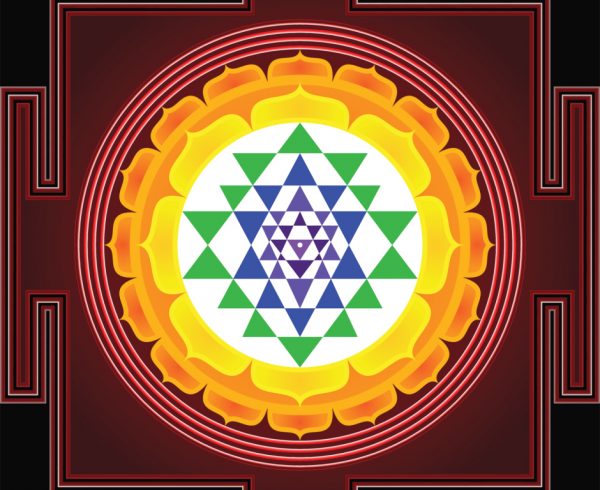When my daughter was unexpectedly awake one night, my grandmother nodded and said, ah yes, the moon.
My grandmother’s theories fall back to the many Vedic and Hindu rituals that follow the moon’s pattern, specifically Purnima and Amavasya, the full and new moon.
Hindus perform a yagna or havan on Purnima called the Maha Mritunjaya havan to honor the power of the moon and what is regarded as an auspicious time. First one would take a bath to cleanse the body and wear clean clothes. He or she then would prepare a bowl of sweet rice and adds black sesame seeds, diced ‘kush’ grass, some vegetables and butter to put beside the havan. After preparing the havan kund, which is a special dish used in the ritual for the fire, on a designated area, a layer of sand is spread and then a tent-like structure of wooden logs is placed in the dish and smeared with ‘ghee’, (clarified butter). In India, one would take three sips of Gangajaal or holy water from the Ganga river while chanting “Om Vishnu” and light the fire by placing camphor on the wood. Lord Vishnu along with other Gods and Goddesses are invoked followed by chanting vibrational mantras with offerings (from the bowl of rice mixture) into the fire.
[cm_ad_changer campaign_id=”1″ debug=”0″]
What’s interesting is that these moon rituals are found in other ancient cultures, as well.
In Ancient Chinese tradition, the Mooncake Festival, also known as Mid-Autumn Festival, falls on the 15th day of the eighth lunar month. Historically, it was a harvest festival for farmers but traditionally, women worshipped Chang-E, the moon goddess.
Mooncakes which are eaten during this time are also known as “reunion cakes” as family members gather to partake of the sweet dessert.
The tradition involves children to carry lanterns of all shapes and sizes in the evening time, which was something that began back to a 14th century revolt by the Chinese against the Mongols. (In 1376, the Chinese overthrew the Yuan/Mongol dynasty in an uprising brilliantly started by lantern-bearing messengers who delivered mooncakes with hidden messages).
In modern day, altars are set up outside the house facing the full moon on the night of the festival. It is regarded as the perfect moment if someone catches the moon’s reflection in the center of his or her teacup while looking up at the harvest moon, which is at its brightest and roundest that time of the year. Respecting it’s powerful stare can help one’s harvest and give good luck to families all year.
Modern studies are also finding the moon’s glow to be more than just an old wive’s, or in my case, grandma’s, tale.
A recent study finds that around the full moon, humans get less sleep and their slumber is not as deep, even if sleep is restricted to windowless rooms that are free of environmental and even time-based cues—such as those found in a sleep lab. The findings, published in Current Biology, suggest that restful sleep takes a blow during a full moon as well as a few days before and after the phase. The authors found that during and for the few days surrounding the full moon, which is the period in its monthly phase cycle when it is brightest and we find it appears in the sky from sunset to sunrise, it takes about five minutes longer to fall asleep, sleep duration is reduced by 20 minutes and slumber is just not as deep.
Led by Christian Cajochen, the head of the Center for Chronobiology at the Psychiatric University Hospital at the University of Basel in Switzerland, researchers studied 33 volunteers in a laboratory environment while they slept. The group was split evenly among men and women and included both young adults between 20 and 31 years old and individuals ages 57 to 74. The same types of sleep patterns were witnessed in both groups.
Their work remains the first to suggest a strong correlation between lunar cycles and sleep deprivation. While the study participants slept, their brain patterns were monitored along with their eye movements and their body’s hormone secretions. The researchers found that brain activity related to deep sleep dropped by 30 percent and the study participants also showed reductions in their levels of melatonin, which is a light-sensitive hormone that helps control the natural sleep–wake cycle. The participants also reported in a subjective questionnaire that they actually felt tired right around the full moon. On average, their sleep quality was approximately 20 percent worse during the full moon as compared with the new moon, according to the data.
The ancients must have been onto something then, because that moon must have A LOT of energy to actually shift our sleep cycle.
And so since the full moon pours down a tremendous amount of energy, it’s best to be in a calm state of mind to receive a positive effect rather than finding yourself moonstruck crazy, tossing and turning in bed. Try to meditate these nights to harness the moon’s power, concentrating on her full shining face and see if that shift’s anything…maybe even more than just your sleep.
References:
http://www.scientificamerican.com/article/it-must-be-the-moon-tired/








It would be good for many ppl to do as I’ve intended for ages; each night, keep a small journal of sleeping & other daily habits, general moods, etc., as well as physical, circumstancial, & other factors that may be affecting them, w/o paying attention to the lunar phases. After several months, see if any patterns have formed.